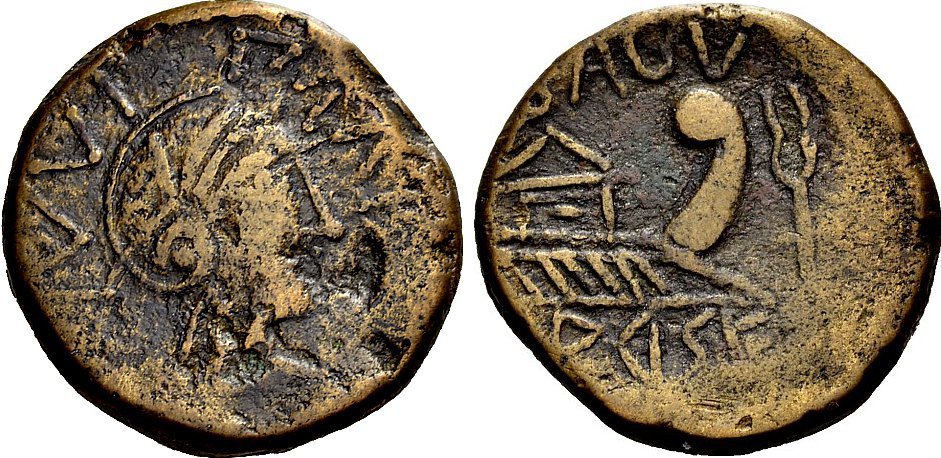S 1678 - Arse-Saguntum, bronze, asses (72-30 BCE)
From SILVER
72 BCE - 30 BCE Bronze
Description
| ObverseInscription or printing placed on the obverse.: | (Iberic).Head of Roma with helmet on right, Iberian legend BiKuLAKoS on front and BaLKaLTuR on back |
| ReverseInscription or printing placed on the reverse.: | SAGV (Latin) "Arse" (Iberic) (Iberic; Latin).Ship's prow right, in front caduceus, above legend SAGV, below Iberian legend ARSE |
Mint and issuing power
| MintIdentifies the place of manufacture or issue of a numismatic object.: | Arse-Saguntum | Ancient regionAncient region.: | Hispania Citerior | Modern countryModern country: Spain | AuthorityIdentifies the issuing power. The authority can be "pretended" when the name or the portrait of X is on the coin but he/she was not the issuing power. It can also be "uncertain" when there is no mention of X on the coin but he/she was the issuing power according to the historical sources: | Roman Republic |
Chronology
| FromIdentifies the initial date in a range assigned in a numismatic context. | 72 BCE | toIdentifies the final date in a range assigned in a numismatic context.. | 30 BCE | PeriodTime period of the numismatic object.: |
Physical description
| MetalThe physical material (usually metal) from which an object is made.: | Bronze |
Median weightMedian of the weights of numismatic objects (in grams). in grams | 13.50 | DenominationTerm indicating the value of a numismatic object. Examples: tetradrachm, chalkous, denarius.: | as |
StandardStandard.: |
Image

S 1678 - Arse-Saguntum, bronze, asses (72-30 BCE).jpg [1]
References
| Die study referencePublication of the study: | Ripollès - Llorens 20021Ripollès - Llorens 2002, p. 464-473, n° 383-397: O201-207/ R275-283 (Period IV) | ||
| Coin series referenceReference to coin series study: | |||
Obverse dies distribution
| FrequencyFrequency of specimen in distribution. ᵖ | Number of obversesNumber of obverse dies. ᵖ (o) | % (o) | Number of coinsNumber of coins. (n) | % (n) | Die nameName(s) of the die(s). |
| 3 | 1 | 14.29 | 3 | 2.78 | 207 |
| 4 | 1 | 14.29 | 4 | 3.7 | 202 |
| 10 | 1 | 14.29 | 10 | 9.26 | 205 |
| 13 | 1 | 14.29 | 13 | 12.04 | 204 |
| 22 | 1 | 14.29 | 22 | 20.37 | 201 |
| 26 | 1 | 14.29 | 26 | 24.07 | 203 |
| 30 | 1 | 14.29 | 30 | 27.78 | 206 |
| Total | 7 of 7 | 100.03 | 108 of 108 | 100 |
Reverse dies distribution
no distribution is available
Quantification
| Number of obversesNumber of obverse dies. ᵖ (o) | 7 | Number of singletons (o1)The number of singleton coins. ᵖ | |
| Number of reverse diesNumber of reverse dies. (r) | 9 | Number of coinsNumber of coins. (n) | 108 |
| Coins per obverse dieNumber of coins per obverse die. (n/o) | 15.43 | Coins per reverse dieNumber of coins per reverse die. (n/r) | 12 |
| Reverse per obverse ratioRatio of obverse dies divided by reverse dies. (r/o) | 1.29 | Percentage of singletons (o1)number of coins (n) divided by the number of singletons (o1) ᵖ | % |
| Original number of dies (O) (Carter 1983 formula)The estimation of the number of coins according to Carter 1983 ᵖ | 6.9 | Coins struck if 20,000 as average productivity per dieCoins made if the average productivity for obverses (according to Carter) is 20,000. ᵖ | 138,000 |
| Original number of dies (O) (Esty 2011 formula)The estimation of the number of coins according to the singleton formula in Esty 2011 ᵖ (O) | 7.49 | Survival rate if 20,000 as average productivity per dieSurvival rate if average productivity is 20,000. ᵖ | 0.00078 |
| Coverage (o = % of O) (Esty 1984 formula)Esty 1984 - coverage (% of O) ᵖ (o = % of O) | % | Die productivity if survival rate 1/2,000Average productivity if survival rate is 1/2,000. ᵖ | 31,304.35 |
| Weight of silver (in kg) if 20,000 coins per die (O = Carter formula)Carter 1983 * Median weight * 20000 (*10 if gold or electrum) ᵖ | n.a. | Die productivity if survival rate 1/5,000Average productivity if survival rate is 1/5,000. ᵖ | 78,260.87 |
Remarks
Most likely one single workstation See chart p. 204
References
- ^ Ripollès, Pere Pau - Llorens, Maria del Mar (2002), Arse-Saguntum. Historia monetaria de la ciudad y su territorio, Sagunto, Bancaja, 564 p.